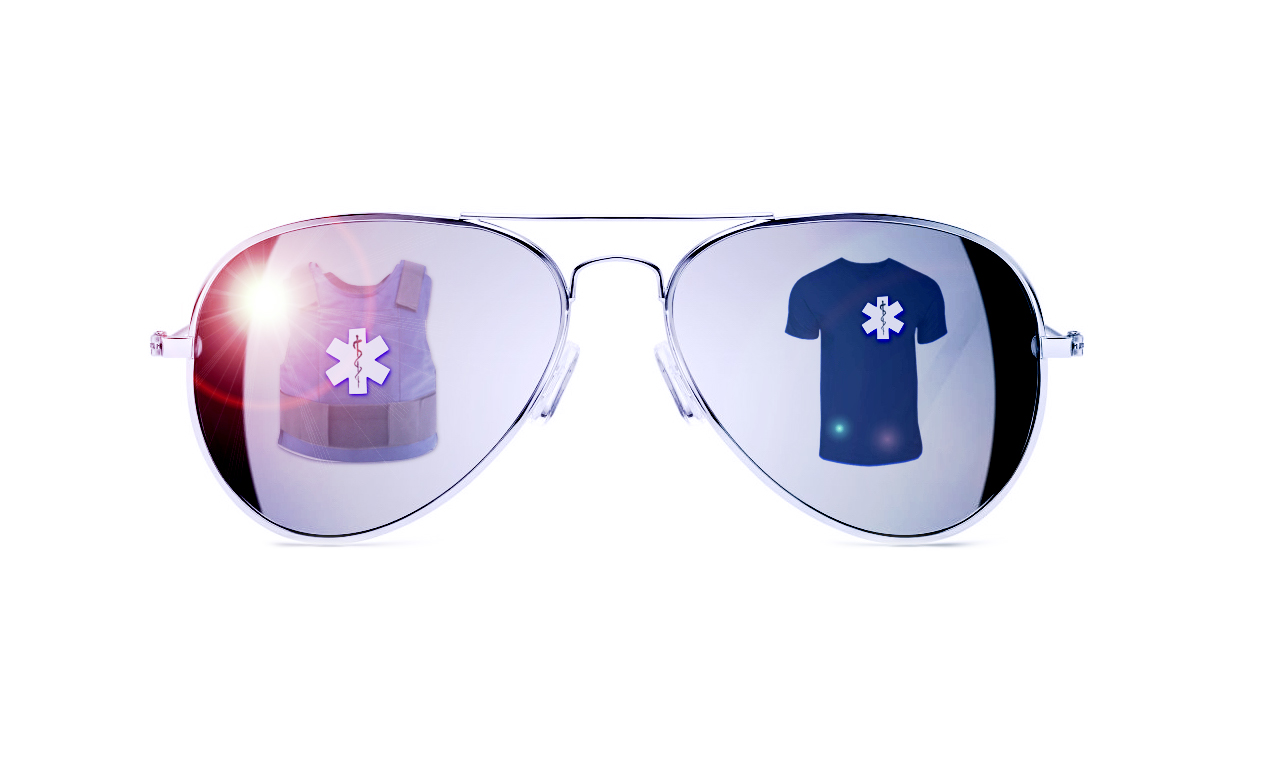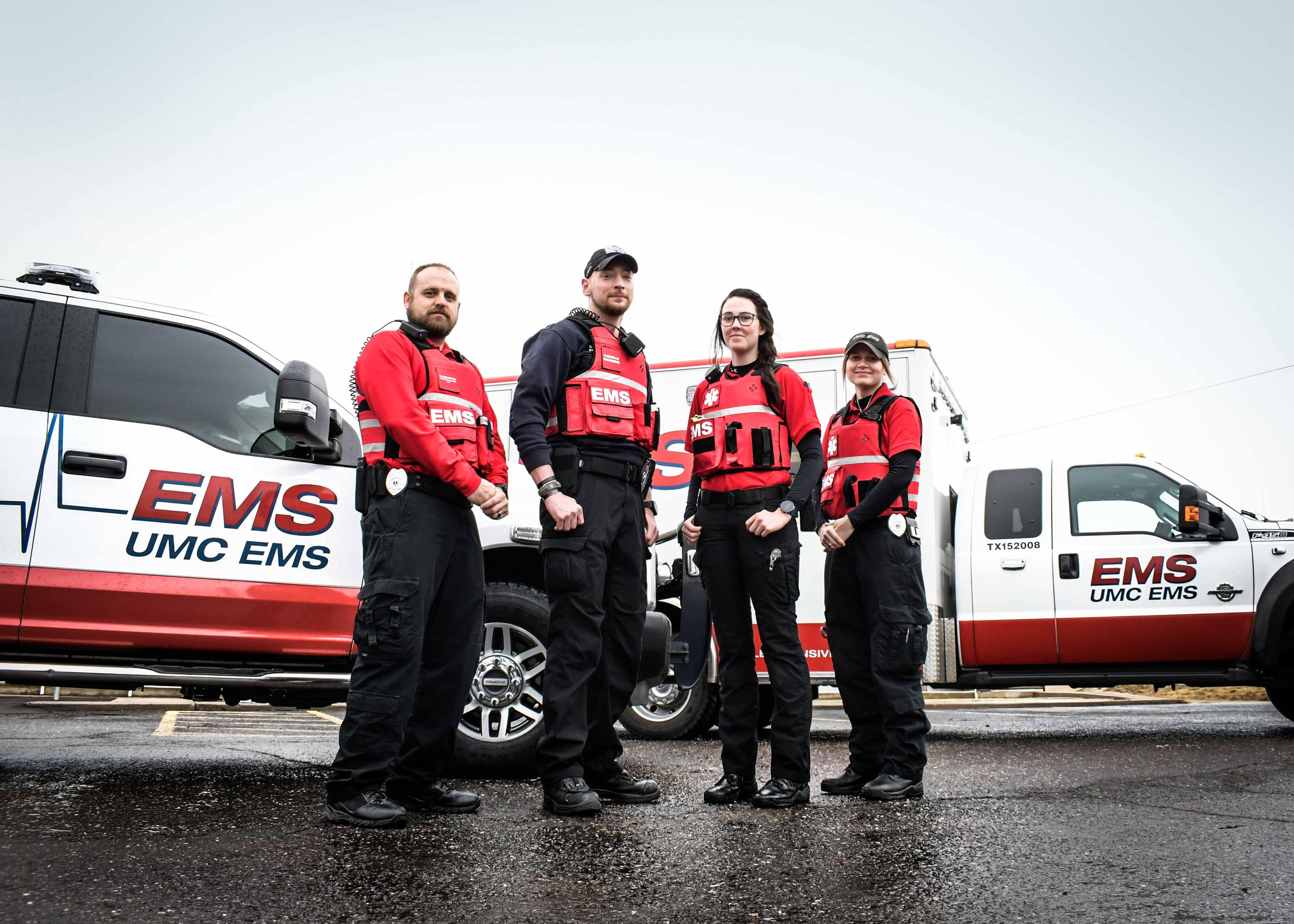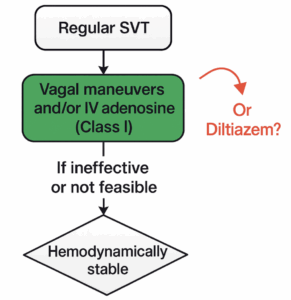by Noah Tyler, EMT-P
Peer Review by Aurora Lybeck, MD
We’ve all seen the news stories and videos: Mass shootings, violent gang activity, and targeted assaults on first responders are on the rise. Fortunately, bullet and stab resistant vests have been effectively protecting most of our law enforcement officers for years.

Today, we see EMS personnel wearing ballistic armor to every call. But wait a minute… we’re medical people, not one of those proverbial sheepdogs who protect the flock. Is this overkill for EMS? Are we addressing a blatant disregard for scene safety with a quick fix instead of education? Are “tactical paramedic” ambitions jousting towards Don Quixote’s windmills? Aren’t most violent or weapons-related responses contained and controlled by law enforcement long before paramedics step foot on scene? They are in Lubbock, Texas… we call it “staging” in the area. So why are we wearing ballistic vests for body armor?
A little history: A few years ago, our hospital-based EMS recognized the increasing rate of violence within Lubbock and began considering options to protect our EMS personnel without impeding patient care. Our agency acknowledged that just like in the rest of the country, there were shootings, stabbings, and mass casualty threats within our city of nearly a quarter of a million people. That said, we also had a strong, dedicated police force to keep us safe and we worked well together.
Now jump ahead to 2018 — Our hospital purchased ballistic vests for every field EMT, paramedic, and supervisor within our service. It was not a strategically-planned and targeted weapons attack that brought about this change in protection. There was no conflict or concerns about police protection for our staff. Instead, it was the enormous rise in synthetic cannabinoid and bath salt abuse from 2013-2017 and the subsequent rise in calls for excited delirium, where we were confronted with patients who could not even be controlled with our standard sedation drug, Midazolam (Versed). Small foil packets of tainted grass and other dried vegetation – something innocently named “Scooby Snax”, “Breeze”, or “Mr. Happy Potpourri” – sold for just $5 at the local smoke shop were presenting risk of serious injury to not only patients, bystanders, law enforcement, but our EMS personnel as well.

Intramuscular ketamine quickly became our medication of choice to protect and tame the patient, as law enforcement was not always deployed for our scene safety needs as these 9-1-1 calls may have come in as an unknown medical, vomiting, seizures, or check welfare. We saw a need for ballistic vests to protect ourselves from the weapon threats usually involved in these patient encounters.
With multiple raids on smoke shops, improved legislation on synthetic cannabinoid sale and prosecution, and targeted efforts by Lubbock police working with state and federal agencies, the synthetic epidemic finally tapered down. But Lubbock’s population was increasing and as with any growing city in the US, the rate of violence was on the rise. Two of our EMS stations were shot at in a single night – fortunately, no one was injured.
Improved dispatch algorithms for EMS and law enforcement evolved and police were responding to the suspected weapons calls and now more potentially-violent excited delirium patients. 2018 seemed safer, so again, do we really need all of that expensive body armor?
The ball was already rolling through the finances department and UMC approved the purchase of the armor. Our EMS staff started wearing the lightweight ballistic vests for those just-in case encounters with a violent, armed patient or questionable scene. While the past history of violent events led to body armor use, we soon discovered a previously-unrecognized benefit in our daily meat-n-potatoes type responses.
One of our frequent 9-1-1 requests is the “check welfare” call where a friend or family member has not heard from an elderly parent, college-age son, or friend with an extensive medical history in several days. Most of these concerned callers are living in another city or state and can’t just drive and check on the individual. Or, a home medical alarm company contacts EMS for an elderly person who has fallen and is unable to stand back up. These encounters are usually not a safety threat and we prefer to preserve our law enforcement resources for more pressing needs.
There is something unique about Texas though, and particularly in the western part of the state: It seems that just about every man, woman, and child owns a gun. Yes, even in Texas, a child can legally own (but not purchase) a gun. Most individuals are responsible gun owners, and it’s not uncommon to walk into a home and see a locked steel gun safe weighing hundreds of pounds sitting in a corner of the bedroom. But, Texas paramedics and EMTs don’t suddenly run out of the house screaming, “scene safety!” — in contrast, it usually spurs a conversation about the gun collection and an exchange on the latest wisdom about hunting rifles. Having trouble with small talk for assessing decisional capability? Start with a few words about the upcoming deer season or wild hogs tearing up the farm fields and you won’t have to say a word. Your patient will do all of the talking.
So, going back to body armor: Are these hunters trying to kill our paramedics? Absolutely not. Instead, the ballistic vests find their value in the unexpected encounters. For example, we responded to a “check welfare” call where the out-of-state son was concerned about his father with recently-diagnosed mild dementia. His father is highly-functional and lives at home with occasional visits from friends and community health partners. The son frequently calls his father to check up on him, but this time he did not answer the phone so the son called 9-1-1. We arrived on scene and knocked on the door, which happened to be unlocked — another west Texas behavior.
While entering the residence, we announced ourselves as EMS and heard no response, so we cautiously continued into the home. As we entered the hallway, a frail elderly man was found frantically rolling his wheelchair down the hall. His eyes were fixated on the doorway behind us and he wouldn’t respond to our questions. He didn’t seem to understand our role or purpose and instead was intent on pushing past to the door behind us. As I glanced behind me, I saw exactly what he was driving towards: A double-barreled shotgun resting on the door post. He was exerting every effort towards getting his hands on that weapon because in his mind, two intruders were in his home and they were the threat.
Dementia is a horrible disease. His case was supposed to be mild, but when coupled with an acute urinary tract infection that altered his mental status, he was doing exactly as we should expect him to do. He was protecting his life and his home, responding instinctively as any normal Texan would confronting a home invasion. I was able to secure the weapon before he reached the doorway and eventually calmed him, but what if his hands got to it first? What if shots were fired just as we entered the doorway earlier?
Another response involved a call for diabetic complications out in a more rural area of the county. In this case, we arrived to find the front door wide open and obtunded patient sitting in the hallway. His blood glucose level was 30 mg/dL, and while occasionally agitated, he didn’t appear to be an immediate threat. Just your standard-issue hypoglycemia call near the “passed out” stage with a known diabetes history. While administering the IV dextrose solution (D10W), I noticed that house was in disarray, in need of a lot of repair, and it looked like candy was scattered across the floor — he must have been aware that his blood glucose was dropping but couldn’t fix it on his own soon enough.
My partner was looking for a medical history or medications list in the house, and he stepped out of the nearby bedroom saying, “You need to see this”. We changed places and as I walked into the bedroom, I saw well over 80 bullet holes in the ceiling, walls, and furniture. Handguns and rifles were strewn across the bed and floor. I immediately requested law enforcement and as they arrived, the patient regained most of his mental status. He was calm, confused about our presence, but then remembered: He knew his blood glucose was dropping and dropping fast. Decades of his difficult-to-control diabetes also taught him that he’d soon lose his ability to make sound decisions and didn’t want to harm anyone. He emptied his weapons, but by that time, his brain chose the most unconventional method.
Guns and other weapons are not the only threat. The human body is a formidable weapon in itself. The ballistic vests have protected our personnel from injuries that previously were once accepted as “part of the job”. Physicians, nurses, and emergency center staff know these risks and injuries well. Hypoglycemia, stroke/brain injury, medication effects, or drug/alcohol abuse can turn an otherwise pleasant individual into a kicking, screaming, biting, fighting weapon of pain. Trying to bathe a cat would be a breeze in comparison. The ballistic vests perform remarkably well in blunting the kicks, fists, and even bites towards our core. These are the potential injuries that can be most disabling for us on scene and risk our safety.
I offer the experience and scenarios not to boast on “war stories” or to instill fear towards every patient encounter. But as we’re taught in our EMS classes and usually soon forgotten, every response has a potential for violence – intentional or not. Complacency can be fatal, but at times we also face situations where the risks will never be discovered until it’s too late.
The individual decision to use body armor is a personal one. Some of our personnel see it as important as donning gloves with every call. Others bring their vests into the ambulance every shift as required by policy, but only wear them during known weapon-involved calls. While every paramedic or EMT is entitled to their own decision to use or not use their vest, it must be an informed one. Body armor’s role is more than protection from bullets and knives during a targeted attack. It’s the everyday calls: The daily hypoglycemia response, substance abuse, brain injury, or even delirium from untreated acute illness.
As experienced providers and mentors, we should instill a culture of safety that embraces the wisdom offered by author and speaker Simon Sinek: “Leadership is absolutely about inspiring action, but it is also about guarding against mis-action.” The action is convincing decision makers that body armor investment for EMS personnel is necessary, while mis-action leads us to assume it’s only valuable for known weapon calls. Consider alternative scenarios to protect yourself and your partner from preventable, disabling injury that in just a moment of time, could destroy your career and livelihood if not life itself.
Response & Commentary
Mark Philippy, EMT-P
I read with great interest the article regarding the wearing of ballistic and protective vests in EMS. This is something of a timely topic, as one of the committees I serve on in New York has this on our agenda as an item of discussion. We have wrangled with the notion of creating a best practices document to help EMS agencies in our state address the need for, and deployment of, ballistic vests. Some areas of the state have been able to move ahead in various ways to provide partial deployment, mostly of threat-level four plate-carrying vests for tactical environments, but few have delved, officially, into daily-wear vest systems.
First, I’d like to be transparent about some of my own biases and experiences.
Among the proudest and happiest days in my life were the first day I put a bullet-resistant vest on – my first day out of the police academy, and the last day I took it off – the day I retired from police work. For 23 years I wore the vest religiously, even though, at the time I started in 1990, it was not required for daily wear as a police officer. There were those in my department who resisted mandatory vest wear, despite the fact that they carried a firearm into every single encounter they ever had with a citizen – a weapon that could potentially be turned against them. Yet by the time I left, it was not even a second thought – the vest went on before the uniform.
Having said that, I hated it, too. It was hot, bulky, stiff, and any time I got into any kind of tussle, I spent a good 20 minutes trying to get it seated right and getting my uniform tucked back in (I’m a bit challenged in that regard, I admit). When agencies such as the Chicago Police Department first started testing the outside vest carriers that looked like uniform shirts, I cheered, hoping it would someday make it to my department (it didn’t, at least not before I retired). I worked bicycle patrol for a number of years and I lost more weight from sweating than I did from the exercise.
Now look at the EMS side of things. In the time that I worked in the City of Rochester, my ambulance had been shot at twice, I had been punched, kicked, bit, and threatened with stabbing, all the while (stupidly, I agree) walking right in with the local police on things that today, we’d stage down the block for until cleared into the scene. At the same time, I scoffed at those medics who wore bullet-resistant vests. Why? Because it was my observation that those who did, immediately seemed to get into more trouble than they had before. Likewise, it seemed the people who got into trouble were the first ones to put a vest on.
By trouble, I mean those few (and we all know them) who managed to rile up every patient with a mental health issue, seemed to draw crowds around themselves at inopportune times, and got more than their fair-share of personnel complaints. These were often the folks whose chest seemed to puff out a little too much, and who seemed to feel they could take on the world single-handedly. I worried for them, and about their partners, all the time.
Fast-forward to 2019. I cannot agree more with the author that things are violent and dangerous. I don’t know that I would agree they are any more so than 30 years ago, when crack cocaine was rearing its ugly head, and excited delirium was still called “cocaine psychosis.” But we are more aware, and we are busier, and so are our law enforcement partners. So the danger may be more visible, in-your-face, not to mention we may be much more aware of it through social media and information sharing. So where is my concern?
First of all, what is the purpose of wearing ballistic or edged-weapon protection? I’m loath to bring up what events transpired in my region some not-so-distant years ago (particularly since it involved a friend and colleague), but in that instance, ballistic vests would not have been of benefit. Yet immediately after that incident, fire departments around the region and the country started talking about buying ballistic vests. My question then as now is, why? When will you wear them? Will you put them on under your turnout gear? Will you wear them on every call all the time? If you’re a career firefighter or EMS provider will you wear it all the time, over or under your uniform?
What does that mean for you, and for your practice? Because I see a good number of people (and police officers now, which irritates me to no end) wearing outside-carry vests festooned with pockets and carry points. So the uniform is no longer the first thing a patient sees. It’s the ballistic vest. We might no longer present the image of primary caregivers, but perhaps be easily mistaken for police. They are bulky, catch on things, and yes, you can take them off, but they still get hot when they’re on, which for practical purposes, should be most of the time.
Let’s talk about under-uniform vests then. For threat-level II or III (and their progeny, IIA and IIIA) vests, under the uniform wear makes sense. It is less intrusive, less visible, and depending on what style is purchased, can be integrated with stab-resistance and water repellency. They are also hot, stiff, and make movement about inside an ambulance, or incident scene, challenging. Uniforms will be untucked and it will be annoying, but you can work through that. The thing to watch out for is the feeling of increased protection morphing into a sense of improved invulnerability. And thence, potentially, increased risk-taking.
What else? Cost. Who bears the brunt of that? The author was fortunate to have a hospital system than was progressive and financially positioned to purchase these, but what about municipal, commercial, not-for-profit, and volunteer agencies? Medicare reimbursements being what they are, we are all holding on by a thread just to upgrade aging cardiac monitors and keep ambulances running. While taking care of our people should be foremost in company leadership’s mind, does that extend to providing this level of protection?
In the law enforcement world, the National Institutes for Justice realized early on that the benefit of protective bullet-resistant vests warranted federal subsidy. For every year that I was on the job, my vest was partially, and in some cases wholly, funded through federal grants. Are those same grants or funding streams available for fire and EMS personnel?
The author points out that it is important for people to make informed decisions about wearing vests. So let’s talk about some limitations and considerations. If you have to buy a vest, I return to the question of what threat level? What are you protecting against? Small arms, rifles, close range, far away? Of much more concern to me is, frankly, edged weapons. However most bullet-resistant vests do not protect adequately from stabbing, thus Corrections’ use of SpectraTM and similar materials in stab-resistant vests. There are those manufacturers who incorporate both (I had one for Bike Patrol) but they are increasingly expensive. So cost and type of protection are key factors in this decision. And I submit few EMS providers, let alone agency leaders, are knowledgeable enough to make these choices, so if you are considering it, best do your research or find yourself a subject matter expert to help.
What about moisture? KevlarTM and TwaronTM fabrics, which make up the bulk of bullet-resistant vest manufacture, are susceptible to becoming soaked through, at which point they lose some or most of their ballistic integrity. This was one reason I chose to use a combined Spectra/Twaron vest for bike patrol. EMS providers are often in the rain, and sweating in cramped, semi-conditioned environments, so how effective will your protection be when the time comes? As a police officer, I had the luxury of being able to go back to my station and swap carriers, keeping my car air conditioned, and making darn sure I wore a raincoat when I was outside for a period of time (most of the time, anyway). That has not always been the case as an EMS provider.
What about training for the intended user? How much training do EMS providers have in the limitations, care, and replacement of bullet-resistant vests? I was acutely aware of the fact that I had a huge open area under my armpits that was not protected. It was never so apparent as when I wore a short-sleeve shirt in changing weather, and could feel the cold air rush up my arm while in a standard bladed stance addressing a potential adversary. Do EMS providers know how to stand to maximize their ballistic protection? Do they know how far down the vest goes, or doesn’t go, to protect their abdomen, and their sides?
Up to this point I’ve somewhat danced around the issues of why we should wear the vest, and written about the challenges and considerations. I don’t think anyone can argue, with any kind of standing, that there is not a place for bullet-resistant and edge-weapon protective vests in the EMS environment. I do believe that there are a good number of considerations that must be addressed before anyone lays a hand on one, or picks up the thread to start obtaining them. The author makes excellent and valid points about the ancillary protective benefits of the vests, from blunt attacks to motor vehicle crashes. I know of a friend who avoided a serious spinal injury during a crash because his ballistic vest acted much like a KED. But when we talk about “lightweight ballistic vests,” let’s make sure we’re talking apples and apples, and not Kevlar and Spectra.
Finally, I agree with the author that there is a particular lack of situational awareness (Oh, how I hate that term!) in EMS today. It is getting better, and there are a number of good programs across the country trying to improve not only provider safety awareness, but EMS defensive tactics (shout out to Kip Teitsort and the folks at DT4EMS). I posit that we should be spending our hard-won funds in this area before we invest in protective vests. Then, and only then, can we fully understand the threat, and address the use of protective equipment effectively.

EMS MEd Editor, Maia Dorsett MD PhD (@maiadorsett)



